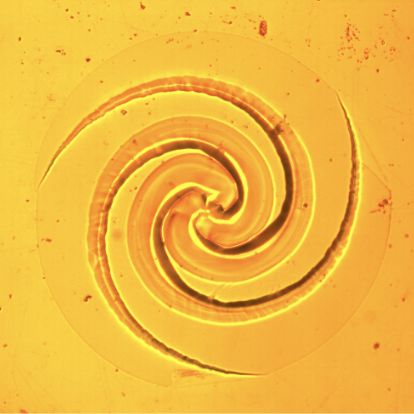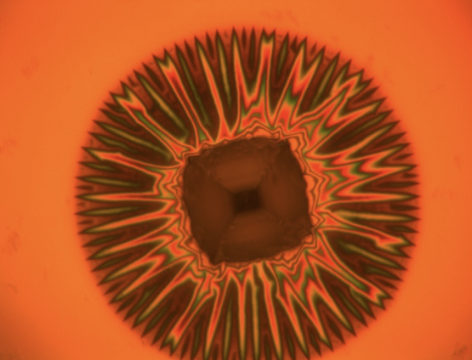Spontaneous Pattern Formation

Three-arms logarithmic spiral engraved on the Ge (100) surface by a spontaneous pattern forming mechano- chemical process. The size of the structure is across.
There are not too many such chemical (non living) experimental systems, so it is exciting to discover new ones. This project is about a solid state system which, starting from homogeneous initial conditions, spontaneously produces rather incredible etching patterns on the surface of Germanium (see picture). The system starts as a laterally homogeneous layered structure of Cr and Au thin films on a Ge substrate. When exposed to a mild etching solution, regular patterns, which are etched into the Ge surface, form over a time of hours. Depending on conditions, one can obtain spirals, radial patterns, or more disordered forms: hundreds of near identical patterns at the scale, engraved at seemingly random locations on a single Ge chip.
The basis for the patterns is a catalytic reaction (metal assisted chemical etching: MACE) coupled to the mechanical deformations of the catalyst, which is the metal film. This form of mechano-chemical coupling is pervasive in the living world, and it is interesting that this inorganic system produces patterns reminiscent of biological forms. The study of this system also intersects several topics of interest in nonlinear dynamics, condensed matter, and engineering, such as the propagation of cracks and thin film instabilities, defects and corrosion, and the fabrication of metamaterials.

Wrinkling of the metal film catalyst observed by interference microscopy in white light. This mechanical instability gives rise to a radial structure etched on the Ge surface. The diameter of the disk is
Associated publications:
- Yilin Wong and Giovanni Zocchi, “Metal Assisted Chemical Etching patterns at a Ge/Cr/Au interface modulated by the Euler instability”, arXiv:2405.20544 (2024) ; to appear in Phys. Rev. Materials (2025).